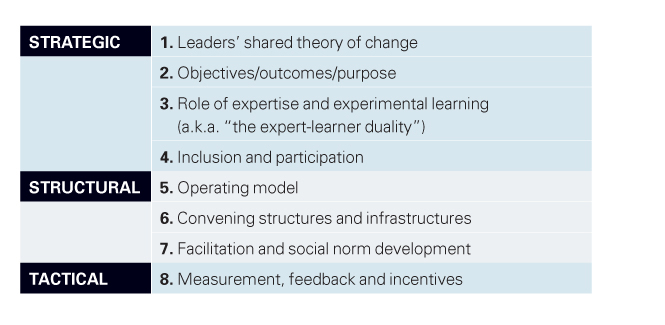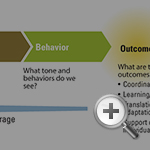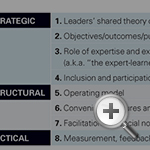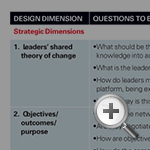Designing Effective Knowledge Networks
In today’s interconnected world, networks for sharing knowledge are increasingly important. By paying careful attention to eight dimensions of network design, leaders of knowledge networks can facilitate desired behaviors and outcomes.
Topics
“Knowledge networks” are collections of individuals and teams who come together across organizational, spatial and disciplinary boundaries to invent and share a body of knowledge. The focus of such networks is usually on developing, distributing and applying knowledge. For-profit and nonprofit organizations of all sizes are seizing on this model to learn more quickly and collaborate productively. However, for every successful network, others have lost steam due to poor participation, goal ambiguity, mixed allegiances or technology mismatches.
Knowledge networks are as old as human commerce, as knowledge was often implicitly exchanged in the production and exchange of goods and services. In the medieval days of guilds and apprentices, formal networks existed between artists, artisans and tradesmen. However, in recent years, Web-based collaboration has streamlined the identification and distribution of codified knowledge, at lower cost and over greater physical distance.1 In his classic 1937 article “The Nature of the Firm,” economist Ronald Coase predicted that companies would grow larger as information costs fell.2 Instead, we have witnessed less the rise of company size than the rise of intercompany collaborations. The knowledge network has been trumpeted as a model for innovation and scale — one that capitalizes on the agility and reach of human connections while integrating practical insight into the day-to-day work of network members. Networks can be 10 people across a handful of organizations or 1,000 people across continents and industries.
Knowledge network members come together around a common goal and share social and operational norms. Most researchers agree that network members participate out of common interest and shared purpose rather than because of contract, quid pro quo or hierarchy. However, researchers don’t agree about the importance of formal structure, organization and leadership. Some emphasize that members are simply “linked together by interdependent exchange relationships” while others call for formalized roles, routines and metrics.3 What’s clear is that knowledge network leaders can influence members’ behavior through network design and facilitation. And that can mean the difference between magnetism and fizzle, between knowledge sharing and hoarding, between inspiration and cynicism.
We sought to better understand the leverage that network leaders have. Much recent writing in both the academic and popular presses about knowledge networks has focused on their outcomes and products, such as knowledge diffusion, new knowledge creation, influence and intercompany and interpersonal connectivity.4 However, there is considerably less attention paid to how leaders systematically initiate and monitor members’ values and behaviors, for example, by reframing inherent conflicts of interest. The question we asked was: How do leaders balance emergent, voluntary “interdependent exchanges” with the practicalities of achieving goals?
Our initial research, funded by the Bill & Melinda Gates Foundation, focused on how knowledge networks could improve the spread of evidence about childhood and maternal nutrition. (See “About the Research.”) We used that research to develop a model of knowledge networks, and later validated our model in organizations outside the international health space. In that process, we developed case studies of ConocoPhillips, the world’s largest independent exploration and production oil company, and Women’s World Banking, a global nonprofit that operates in 28 countries and is dedicated to providing low-income women with access to financial tools and resources. These different examples provided a good test for the model: At ConocoPhillips, knowledge networks are an intermediate good, a means to an end and a vehicle to create products or drive efficiencies. At Women’s World Banking, the creation and diffusion of knowledge is the product — the value Women’s World Banking brings to market.
ConocoPhillips has more than 10,000 unique network members in multiple networks, yielding a membership of more than 30,000 in just over 100 global networks. Each network is purpose-driven, sponsored by functional leadership to connect employees to just-in-time insights on topics as diverse as production engineering and information technology solutions. “We realize that the future of our company will be born out of a web of human conversations,” explained Dan Ranta, ConocoPhillips’ director of knowledge sharing. “Connecting our knowledge workers purposefully gives our company a greater opportunity to create regular, sustainable business value.”
In 2009, Women’s World Banking launched the Center for Microfinance Leadership, with a mission to “develop principled and visionary leaders” for the microfinance industry.5 In 2012, Sarah Buitoni, the Center for Microfinance Leadership’s manager for alumni networks, launched the Women’s World Banking Leadership Community with seed funding from the Cisco Foundation. The goals were to improve the adoption of leadership approaches in the microfinance industry and to extend microfinance industry leaders’ support for each other as they “re-enter” their organizations after attending a training session or conference. “The ability to tap into and leverage a network of experts will drive our success in being responsive to leaders’ needs,” said Buitoni. “At the same time, this will enable us to continue to deliver high-quality programs and raise the bar across the microfinance industry on issues of leadership, governance and diversity.”
Four Knowledge Network Goals
Considerable research shows that unless goals are clearly stated and agreed upon, networks can easily lose energy and underperform.6 Even if network leaders develop and communicate these goals, this isn’t a guarantee that the goals can animate members. We wanted to know if specific purposes and named outcomes call for different network designs. Is the network’s primary purpose knowledge development (for example, through convening, brokering or funding knowledge creation) or the diffusion, scaling and absorption of ideas by knowledge network participants? Depending on the answer, what leadership model and convening process work best?
Answers by knowledge network leaders, consultants and researchers to these questions of designing for outcomes fall into distinct categories. We saw some network goals that were externally focused, collective and product-oriented — such as group coordination and knowledge-capital publication. And we saw some goals that were internally focused or individual-focused, such as problem solving, support of individuals, and member teams’ translation or adaptation into their local context. We discerned four distinct types of goals.
1. Coordination.
When coordination is a key goal, the network coordinates and leverages members’ existing knowledge activities through its structures, incentives and norms. For example, ConocoPhillips’ networks are focused on coordinating specific global practices, mainly in domains related to exploration and production. In one such network, an Australian operation identified a new technique for underwater tank inspections that a partner-operated facility in the North Sea adopted as well, resulting in a coordinated inspection approach that could be optimized across geographies.
2. Learning/Innovation.
When learning and innovation are important goals, the knowledge network commissions, accumulates and distributes knowledge for its members’ consumption, or as a general public good. Some learning is also inward-looking: The network learns systematically about itself and its processes. The Learning Innovations Laboratory, run by Harvard Graduate School of Education’s Project Zero, brings together chief learning officers across a wide variety of global organizations. Project Zero team members convene the knowledge network several times annually in Cambridge, Massachusetts (as well as asynchronously). The 25 chief learning officers in the network routinely explore changes in the landscape for corporate learning, experiment with new practices and return to their organizations to pilot new ideas gained from their participation in the network.7
Women’s World Banking introduced “project circles” for members to synthesize shared practices and artifacts, such as middle management competency models and “re-entry strategies” when alumni return to their organizations after attending a training or workshop. Co-created knowledge products are then published outside the community for public consumption.
At ConocoPhillips, network leaders move closed discussion items into the enterprise-wide wiki (called OneWiki), searchable from multiple network platforms. ConocoPhillips commissions special assignment teams, called workgroups, to solve specific issues, creating explicit practices that are then shared back with the networks.
3. Translation/Local Adaptation.
When translation and local adaptation are primary network goals, teams join the knowledge network to identify and adapt knowledge to their specific local challenges. By joining the network as a unit, they can safely vet and translate new or controversial ideas before returning to their home context. Teams improve their absorptive capacity when they become a “voting bloc.” They don’t simply remix or reframe ideas but become networks themselves, supporting each other back at home through their common experience and vocabulary. For example, Cambridge, Massachusetts-based Institute for Healthcare Improvement’s IMPACT communities are comprised not of individuals but of teams made up of nurses, administrators, physicians, project managers and pharmacists seeking to reduce medical errors and inefficiencies. By joining other teams and “taking off the white coats,” individuals exchange ideas and learning across hospital teams, unfettered by hierarchy. Setting aside the political trappings of rank and power, the team members are also able to reflect together on the relevancy or applicability of lessons about how to put IHI’s healthcare improvement methods into practice.8
ConocoPhillips often works on a regional team-based model, so team-driven translation comes naturally. For example, Canadian business unit members harvested ideas from the unconventional reservoirs network that was mainly working in the Eagle Ford geological formation area of South Texas. The Canadian business unit members attempted to announce those ideas to their local colleagues only after vetting them and adapting them to Canadian geological environments.
Similarly, Women’s World Banking’s Center for Microfinance Leadership is expanding its engagement with entire leadership teams through in-house leadership development programs. In the next phase of its Women’s World Banking Leadership Community, the Center is exploring how leadership teams that have engaged in those programs can capitalize on their new shared language to more rapidly have an impact at home.
4. Support of Individual Members.
When this is an important goal, individuals join the network to develop, accumulate and adapt knowledge to support their own and their colleagues’ work. Support of individual members is the most common goal of the corporate knowledge networks we examined. We also saw this strongly in the global health and development arenas. For example, Knowledge Management for Development, KM4Dev.org, founded in 2000, is an approximately 3,400-member virtual knowledge network that individuals in the international development field can join regardless of their organizational level or accomplishments.
Freedom for an individual to ask questions without manager scrutiny and peer criticism is a central goal of the knowledge network models for both ConocoPhillips and Women’s World Banking. In addition to individuals tapping the network for problem solving, Women’s World Banking has incorporated peer coaching into its network model. For example, two microfinance leaders from Jordan and from Uganda have peer-coached each other with daily check-ins on the topic of time management. ConocoPhillips, meanwhile, promotes network membership as part of the onboarding process for new employees; the company’s knowledge networks help new and experienced hires connect up and down the ConocoPhillips hierarchy from the start.
A Framework for Effective Knowledge Networks
Meeting any of the four goals of a knowledge network requires members to act by capitalizing on the cohesion, conversation and connectedness of the network. Those traits don’t just emerge out of thin air. We sought to understand the larger effects that influence knowledge network performance. Borrowing from the organizational learning field, we studied the knowledge network through the lens of what is called a leverage framework. (See “A Framework for Knowledge Network Effectiveness.”) First, we read the diagram from left to right to see the chain of influences (Design → Dynamics → Behaviors → Outcomes). Then, reading from right to left, we can peel back the layers that lead to the outcomes.
A Framework for Knowledge Network Effectiveness

Outcomes
Outcomes can be described as meeting the four knowledge network goals of coordination, learning/innovation, translation/local adaptation and support of individual members. Depending on the context, the network achieves measurable change in the area of focus, whether that focus is revenue, operations, job satisfaction, learning, sustainability or profitability.
Behaviors
Behaviors are those that are conducive to outcomes: cohesion, demonstration of trust, connection sharing, using a common technology platform and making investments in collaboration, such as taking time out to answer fellow members’ questions. In a successful knowledge network, members identify with the network and its aspirations, readily share their connections inside and outside the network and are committed to moving knowledge sharing to the platform so that everyone can benefit. For example, ConocoPhillips’ network members use a discussion forum called “Ask & Discuss” to ask questions and conduct problem solving through the platform.
Dynamics
Dynamics are feedback loops, the systems and structures that sustain a given behavior. Dynamics can also be patterns of interaction with the outside world, such as reactions to market threats and incentives. For example, in our research for the Gates Foundation, we saw a “safety-absorption pattern” for new ideas: To gain uptake and spread health practices, members who were implementing the new practices needed first to safely inquire into and troubleshoot what they perceived to be translation obstacles. Similarly, members of the Women’s World Banking microfinance network, by participating over time in asynchronous online Alumni Circle discussions — and live Skype conversations — safely “try on” new leadership behaviors in the company of other members before taking those behaviors back to their microfinance institutions.
Design
Design encompasses the set of conditions that network leaders explicitly put in place to trigger those dynamics and, in turn, set behaviors into motion. Highly successful knowledge network leaders that we interviewed saw design as either positive leverage or an Achilles’ heel. They fluently traced disappointing outcomes through the layers of behaviors and dynamics and finally to an overlooked design component. They explained the relationships between design choices and the dynamics they sought and took pains to influence those dynamics. In fact, they saw themselves as social artists, continually tweaking the knowledge network design.
Designing Knowledge Networks for Success
Experienced knowledge network leaders that we interviewed endeavored to create a consistency between structures (such as operating model, charter and technologies) and strategy (such as purpose, network composition and learning context). They used visible performance information and incentives (such as reputation, recognition and sense of belonging) to inspire, motivate and redirect the behaviors of the members. We identified eight design dimensions of knowledge networks. (See “The Eight Design Dimensions of Knowledge Networks.”) The following eight dimensions cover the spectrum — from negotiating leadership to chartering, operating and adapting the network to changes in the social, economic, technical and political environment. (See “Knowledge Network Design Questions to Consider” for the questions to ask about each design dimension.)
The Eight Design Dimensions of Knowledge Networks

Knowledge Network Design Questions to Consider
1. Leaders’ Shared Theory of Change.
Successful knowledge network leaders can describe the mechanisms through which network activities will have an impact on members and organizations. That is, they can state their theories of change. For example, they can state whether members respond and learn from written evidence or from visceral experiences. When they are able to discuss how the network mechanisms work, leaders (including core teams and sponsors) are well aligned and therefore act consistently with each other. They regularly discuss network designs and impacts, for example, choosing the mechanisms that are conducive to support network participants, intellectual capital development or coordination. The theory of change is included in a strategy or charter document.
This design dimension is as much about being explicit about how to have an impact as about how to be a leadership team. We found that good leaders were role models, inspiring members to act, and they did not delegate work such as being online and responding to discussions. They were routinely visible — as a cohesive team — to the community.
For example, ConocoPhillips senior leaders have gone on record endorsing cross-organizational knowledge sharing of their Networks of Excellence as critical to innovation in the company’s exploration and production process. While ConocoPhillips tends to designate senior practitioners and subject matter experts to guide the networks, it expects those leaders to routinely join the fray, answering posts and mentoring other members’ contributions in a moderator role.
At Women’s World Banking, humility and inclusion are basic ingredients in the leaders’ theory of change. For example, when a new cohort of leaders-in-training joined the organization’s Leadership Community four months after the network’s launch, founding member-leaders took the time to write on the “walls” of new members to welcome them to the community.
2. Objectives/Outcomes/Purpose.
Leaders help to define the network’s purpose and target outcomes. Outcomes can be solving a specific problem or combining forces and knowledge. They can be classified as one or more of the network goals described earlier, such as support of individual members. A charter or similar document lays out the network’s objectives and purpose, which need to be sufficiently crisp that members can state them. Objectives are best negotiated in a way that reflects the leaders’ shared theory of change and the goals themselves.
ConocoPhillips’ Networks of Excellence are formal, purpose-driven, global groups with clear coordination and process innovation agendas. Their charters are vetted and approved by senior functional management and must tie to larger global organizational metrics for productivity and innovation. Similarly, Women’s World Banking launched the design process of its Leadership Community by conducting consultations with microfinance leaders to determine which knowledge network goals resonated most closely with their needs and to model a core value and goal of the community — “leaders as experts and drivers of their own learning.”
3. Role of Expertise and Experimentation (also called the expert-learner duality).
Leaders need to be clear on how the network makes it safe for even the expert to be vulnerable and learn and for the learner to speak of bold possibilities. High-performing knowledge network leaders we interviewed thought deeply about how to trade off showcasing experts with supporting members who were stepping into the vulnerability of learning. The leaders did this with a deep understanding of the disparities of knowledge in their membership. For example, they had experts share and mentor, with learners asking questions where there were clear knowledge differences. Or in some cases they designed meetings (for example, using stories, questions or round robins) to set a tone of safety and encourage humility. When grandstanding or retreating occurred, leaders intervened appropriately.
To encourage participation, ConocoPhillips each year awards four Networks of the Year commendations to those networks that don’t just produce solutions but also achieve broad global participation across hierarchy levels. And in the Women’s World Banking Leadership Community, alumni of the Women’s World Banking Center for Microfinance Leadership participate in the community’s core team alongside Women’s World Banking staff — thus bridging the gap between expert, learner and convener. Community members also share stories of survival with one another, and in their interpretation of those experiences, community members play the roles of both expert and integrator.
4. Inclusion and Participation.
Knowledge network leaders position the knowledge network or network program among other operations or competing organizational models. The network’s core team explicitly defines what types of members they seek and actively recruits them. For example, they may seek out cognitive, geographical and professional diversity, or an amalgamation of separate social networks. They may seek to balance technical or operational expertise with convening or networking skills.9 Depending on the network goals, they may guard against having employees from competing companies, have new joiners approved by existing members or require joiners to come in teams.
For example, each ConocoPhillips network has a public profile for attracting members. Managers encourage employees to participate in multiple Networks of Excellence, and network leaders cross-post online discussions to extend the diversity of participation and the quality of problem solving.
By contrast, Women’s World Banking’s network includes “Alumni Circles” that are private, in order to enable senior leaders to freely share challenges they face within a trusted group. However, when posting resources on matters pertaining to the whole community, members may (and often do) share knowledge assets outside the Alumni Circles, for the benefit of all network members.
5. Operating Model.
Knowledge network leaders decide what roles, responsibilities and decision processes are needed for optimal network operations. All stakeholders, including the public, should be described in the operating model, and there should be clarity about how resources are allocated. For example, there may be core team members (including managers of content, membership, events or measurement) as well as small project teams or working groups that assemble for just a few months to complete a task. Typical projects for working groups might involve integrating viewpoints, conducting a survey or drafting a policy. Operations over time are expected to change. The core leadership team may rotate to add fresh ideas and reduce burnout. Schedules are published and tracked.
Operating models for each of the four knowledge network goals could be quite different. Where coordination is critical, core team membership could include representatives of each organization. Where the emphasis is on the individual practitioner’s learning, the operating model may have more roles and more rotations to expand individuals’ learning and social capital. Where the emphasis is on creation of intellectual capital, content manager and synthesizer roles are critical. Where translation by teams of local change agents is crucial, there may be a formal representative of each organization who seeks to take ideas home.
ConocoPhillips’ operating model includes executive sponsorship by functional leaders, network leadership through a core team and support from a centralized support team. Network processes balance ad hoc knowledge sharing with more explicit innovation, authoring and publishing.
At Women’s World Banking, the Leadership Community governing group includes the organization’s grantor (Cisco), network member-leaders and a support team. The support team prepares meeting topics, onboards new members, plans platform improvements and posts training content from the Center for Microfinance Leadership programs.
6. Convening Structures and Infrastructures.
Network leaders understand how online and real-time or live convenings serve to build cohesion, connectivity, collaboration and engagement. Core network teams may develop a matrix proposing what channels or vehicles are used for what purpose and with what members. In our research for the Gates Foundation, we found that despite much excitement about social media and collaboration portals, network leaders and researchers named real-time human connections (meetings, conference calls, video teleconferences) as prerequisites for trust building and knowledge sharing. This is consistent with recent research that found that teams’ performance correlated directly to the frequency and variety of real-time interactions.10 The degree of face-to-face and voice-to-voice interaction depends on the network objectives. Rapid idea development and innovation require live discussions (online or in meetings), while intellectual capital management requires document management and broadcast communication.
Network leaders look for evidence of success or failure in network participation, as well as ways to incentivize people to join, participate and engage.
ConocoPhillips’ collaboration platforms have both document sharing and social functionality such as discussions, activity feeds, wikis, chat and notifications. The company emphasizes the text-based, asynchronous mode of communication, which the company’s network leaders call “the great equalizer” for people for whom English is a second language. Increasingly, ConocoPhillips is bringing the network to the members, rather than making members go out to a network platform. The company is using a feed of knowledge network content in day-to-day process applications, such as purchasing. Semantic analysis of users’ work (predicting what content users are more likely to access and reuse) is shortening search and browse times on network platforms.
Women’s World Banking built a collaboration website where members discuss topics, share documents, read activity feeds and collaborate on wikis, chats and discussions. The nonprofit has placed a strong emphasis on real-time interaction, using Skype to enable leaders to speak directly to each other. The organization strives to align diversity of technology with member diversity. “Technology allows learning to continue well after an in-person training,” said Charu Adesnik, corporate affairs manager at Cisco. “The [Women’s World Banking] Leadership Community is drawing together a diverse set of microfinance leaders who now have a global platform to share best practices and access resources that improve the impact of their services.”
7. Facilitation and Social Norm Development.
Knowledge network leaders take on the roles of facilitators and change agents, not just project managers. They convene members in meetings, discussions, games, events and other interactions to draw out their hidden insights or to provoke a common curiosity.11 In high-performing networks, network leaders agree about how to model and develop positive interactions within the network. Social norms — such as inclusion, openness, transparency, accountability, curiosity and quality — are integrated explicitly into the facilitation processes. For example, respect for diversity could be conveyed in the tone and language of meeting agendas, discussions, blogs and quick polls.
The core team members for ConocoPhillips’ networks are asked to prod discussions, periodically nudging, playing back or “translating,” in addition to asking probing questions. In network leader Ranta’s words, they draw out the “know-how, know-what and know-why” to help others solve problems and learn. Women’s World Banking Community administrators, meanwhile, play a clear convening role but draw on members to act as facilitators of Skype calls and webinars, thereby modeling the network’s norm that network participants own the agenda.
8. Measurement, Feedback and Incentives.
Network leaders look for evidence of success or failure in network participation, as well as ways to incentivize people to join, participate and engage. One goal is to signal to outsiders and sponsors that the network is effective. Metrics must be credible and appropriate in terms of effort and relevance. Network performance metrics are elusive, as outcomes are often felt at the members’ home organizations and thus are separated in space and time from inputs like discussion participation. Leaders address these delays between knowledge network behaviors and impacts by having a map that shows the pathway between inputs and outcomes. There are clear checkpoints during the monthly or quarterly schedule when network leaders look at performance data and look at improvements to plans. Incentives include the extrinsic (community celebrations or letters or appreciation directed to managers or network members) as well as the intrinsic (learning something new or solving a problem quickly). High-performing network leaders manage to minimize bureaucratic review and tie performance to incentives quickly so that members feel pride, connection and even healthy competition.
ConocoPhillips routinely publicizes the business impacts of its Networks of Excellence. For example, recall the anecdote mentioned earlier about how a North Sea business unit adopted a technique for underwater tank inspection from an Australian business unit. The company also publishes input statistics, such as membership and discussion posts, as well as numbers of published lessons learned. Network participation and knowledge-sharing rates roll up to functional and business unit performance metrics, which link to a discretionary portion of ConocoPhillips employees’ variable compensation. Ranta is clear on this issue: “If you are not in a network that can help your work, or if you are not active, you are not contributing to the greater good of the company.”
The Importance of Knowledge Network Design
In his foreword to a 2011 United Nations publication called “Networks for Prosperity,” Jan Wouters, director of the Leuven Centre for Global Governance Studies at KU Leuven, wrote: “Networks, formal and informal, local and global, are increasingly important channels for pursuing policy goals in a globalizing world.”12 Knowledge networks are clearly vital to our connected world. Yet our research indicates that we, as leaders, must be thoughtful about how we design and manage them. Though much network behavior is emergent, the way network leaders catalyze action makes a difference. The network effectiveness framework and, in particular, the eight design dimensions offer a holistic approach for achieving collaboration, network cohesion and broad connectivity — which, in turn, help yield the important outcomes of coordination, learning/innovation, translation/local adaptation and participant support.
References
1. A. Jacobson and L. Prusak, “Unlocking the $2.6 Trillion Challenge: Measuring Knowledge Transactions,” unpublished ms.
2. R.H. Coase, “The Nature of the Firm,” Economica 4, no. 16 (November 1937): 386-403.
3. See, respectively, J.G. Stein, R. Stren, J. Fitzgibbon and M. MacLean, “Networks of Knowledge: Collaborative Innovation in International Learning” (Toronto: University of Toronto Press, 2001); and E. Wenger, R. McDermott and W.M. Snyder, “Seven Principles for Cultivating Communities of Practice,” chap. 3 in “Cultivating Communities of Practice: A Guide to Managing Knowledge” (Boston: Harvard Business Press, 2002).
4. N. Christakis and J. Fowler, “Connected: The Surprising Power of Our Social Networks and How They Shape Our Lives” (New York: Little, Brown and Company, 2009); and J.D. Johnson, “Managing Knowledge Networks” (Cambridge, U.K.: Cambridge University Press, 2009).
5. “Women’s World Banking Center for Microfinance Leadership Strategy for 2012 to 2015,” internal document.
6. E. Wenger, B. Trayner and M. de Laat, “Promoting and Assessing Value Creation in Communities and Networks: A Conceptual Framework,” white paper, Ruud de Moor Centrum, Open Universitat, The Netherlands, 2011.
7. K. Pugh, B. Camson and D. Wilson, “Practices of a Successful Knowledge Network,” working paper, Learning Innovations Labs, Harvard University, Cambridge, Massachusetts, 2011.
8. K. Pugh and J.A. Endo, “Jamming with the Institute for Healthcare Improvement,” Ask Magazine, winter 2011, www.nasa.gov.
9. S. Page, “The Difference: How the Power of Diversity Creates Better Groups, Firms, Schools, and Societies” (Princeton, New Jersey: Princeton University Press, 2007).
10. A. Pentland, “The New Science of Building Great Teams,” Harvard Business Review 90, no. 4 (April 2012): 60-70.
11. K. Pugh, “Sharing Hidden Know-How: How Managers Solve Thorny Problems with the Knowledge Jam” (San Francisco: Jossey-Bass, 2011).
12. “Networks for Prosperity: Achieving Development Goals Through Knowledge Sharing” (Vienna, Austria: United Nations Industrial Development Organization, 2011), 17.
i. For an excellent bibliography on other research about knowledge networks, see C. Phelps, R. Heidl and A. Wadwa, “Knowledge, Networks, and Knowledge Networks: A Review and Research Agenda,” Journal of Management 38, no. 4 (July 2012): 1115-1166.


 View Exhibit
View Exhibit View Exhibit
View Exhibit

Comments (7)
Ray Collins
Joy Marie Rivera
Nik Zafri Abdul Majid
Gerardo Rodriguez
Katrina Pugh
Leslie Brokaw
pablopena